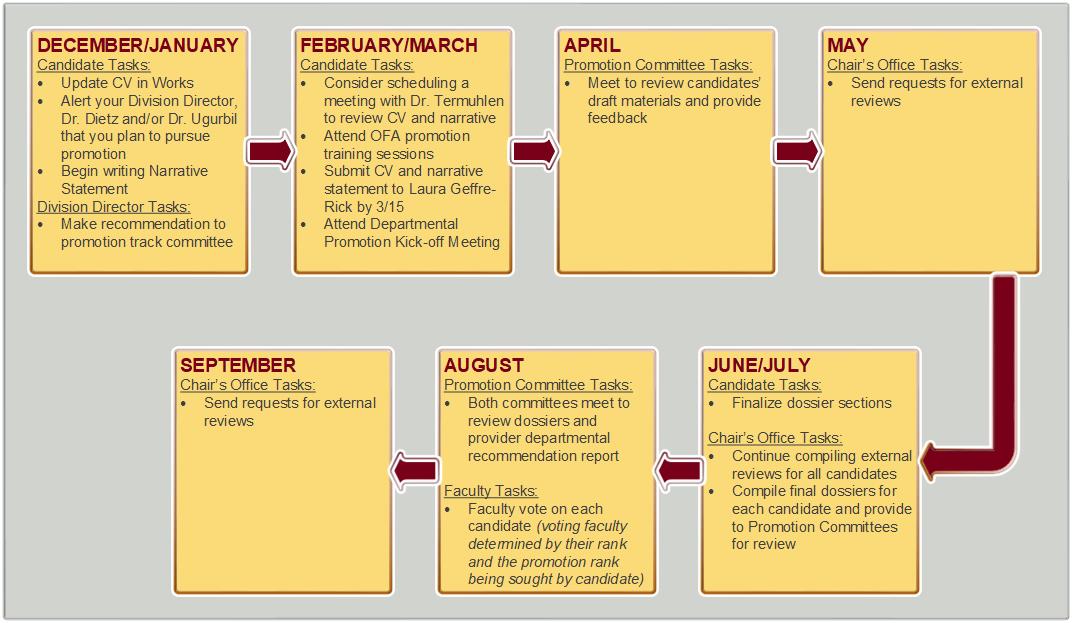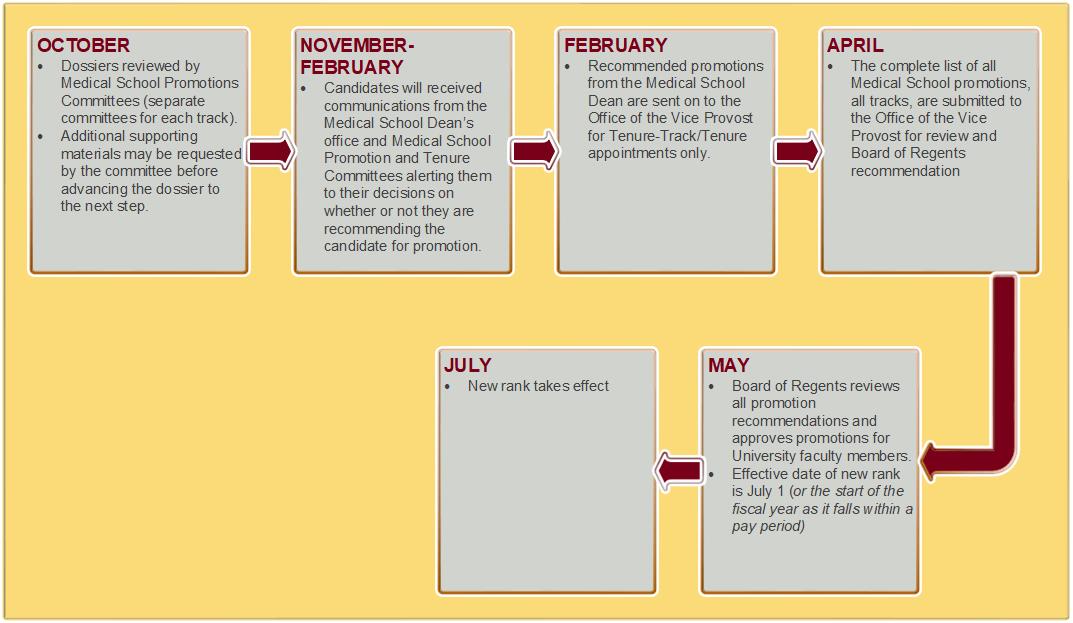Promotion & Tenure
Timelines and Process
Pursuing promotion involves assembling a detailed dossier of your accomplishments toward the University's tripartite mission. Our department is prepared to give you the guidance and tools you'll need to prepare a dossier that will lead to successful promotion.
Perhaps the most important thing you can make a habit of now, no matter the stage in your career, is to keep detailed records of your accomplishments. Regularly update your curriculum vitae, actively participate in the department's annual faculty review process, and meet with your promotion mentor on an ongoing basis.
Please be sure to fully review the items in the below checklists that you will need to complete your dossier. You may need to work well in advance of the due dates to ensure you have ample time to request items, such as peer reviews or data.
Contact your division director or Dr. Dietz with any questions you might have about the promotion process.

Department of Radiology Promotion Timeline

Review and Approval Timeline
Review Committees
Two committees are responsible for the review of candidates for promotion and providing recommendations. The committees meet annually in April to review CVs and draft narrative statements from potential candidates for promotion and provide feedback regarding readiness for promotion.
The committees then meet again to review final dossiers and provide the department report, to be included in each dossier.
- Academic and Tenure Tracks Committee Chair: Noam Harel
- Clinician Track Committee Chair: Jessica Kuehn-Hajder
Promotion Progress
Getting ready for promotion is a process that starts the day a faculty member is hired. It involves identifying a scholarly focus area and working and meeting regularly with mentors to help develop that focus area and a scholarly product. Over time, continuous, progressive scholarly productivity is expected, and this should be well documented. Accomplishments for promotion are documented within three formats: SAFE forms and/or Form 12/12a, your Curriculum Vitae, and your Narrative Statements.
CV
The CV should utilize the Medical School Works format. Emphasis should be placed on these areas: Research/Scholarship, Teaching Service, Professional Service, and Clinical Service. These are the 4 categories that are described in the personal statements and ultimately that reviewers will be asked to assess at the time of promotion. Appropriately categorizing academic activities from the beginning saves work when the time for promotion nears, and also allows faculty and their mentors to regularly assess readiness for promotion and determine where there are "holes" that need to be addressed. The CV should be updated at least twice a year, in June and December.
Candidate’s Narrative Statements
The promotion dossier contains a candidate's narrative statement summarizing your accomplishments. The narrative statements provide concise summaries for the Promotions Committee and for referees being asked to write letters. See examples and details in your track’s section.
Annual Appraisals
Each Medical School department must submit annual appraisals for faculty members through the Works, Medical School Annual Review Narrative process. The appraisals or reports should cover the previous calendar year. Tenured and tenure track faculty will use both the Works process and Form 12 document.
Promotion and Tenure Voting Procedures
Eligible Voting Faculty
- Tenure track dossiers: Tenured faculty at the proposed rank and above are eligible to vote.
- Academic track dossiers: Faculty on all tracks at the proposed rank and above are eligible to vote.
- Clinician track dossiers: Faculty on all tracks at the proposed rank and above are eligible to vote.
Voting Process
- Dossiers are first reviewed at a meeting of the appropriate departmental P&T committee and a summary recommendation is prepared by the Chair of the Committee to be shared with the eligible voting faculty.
- The dossiers and committee recommendations are emailed to the eligible voting faculty. The voting window will be outlined in the email.
- Vote.umn.edu is used to collect all votes anonymously from the eligible voting faculty for each candidate. Eligible faculty receive an email link to vote in favor, against, or abstaining from voting for each candidate. Voting faculty are also able to enter comments about each candidate’s dossier through this voting tool.
- Once the vote is closed, the totals are passed on to the Vice-Chair of Faculty Affairs and the Department Chair for inclusion in the Department Head Recommendation, to be included in the dossier.
Required Majority
- Tenure track dossiers: A positive vote by two-thirds of all eligible voting faculty members is required to affirmatively recommend promotion in the tenure track. A quorum (more than two-thirds of the faculty members eligible to vote) must participate in the vote for promotion and tenure. The number of abstentions is reported as part of the vote tally and, in the review process, they will be considered an indication of lack of support for the candidate by those abstaining.
- Academic track and Clinician track dossiers: A positive vote by more than 50% of eligible faculty who vote in the Department of Radiology will be considered favorably for promotion in the Medical School. All full-time faculty holding appropriate appointment and rank, including those at affiliated sites, are eligible to vote on recommendations for promotion of candidates in both the Academic and Clinician Track.
Academic and Tenure Track Dossier Preparation
For the most current dossier templates and sample documents, please refer to the Office of Faculty Affairs pages for Tenure-Track, Tenure, and Academic Track promotions.
Updating your CV
You will need to include a CV with fully annotated bibliography. You’ll also need to insert an Impact Analytics Grid into your CV at the top of your Publications list. This grid should be pulled from Manifold. You will need to include the journal impact factor, number of times cited, and your role in multi-author publications (for publications completed during your current rank).
If you utilize Works, you can add this information into the entry for each publication. The Office of Faculty Affairs prefers you utilize Manifold whenever possible for your analytics and citation information. If you do use another source (Google Scholar, Web of Knowledge), be sure to indicate where the citation count was found.
Writing your Candidate Narrative Statement
Your Candidate Narrative Statement should be 3-4 pages (absolutely a maximum of 4 pages).
The goal of the promotion narrative statement is to provide a cohesive narrative about your contributions to the mission of the Medical School. It is also a way of highlighting your focus (your primary mission area), your accomplishments and their impact on your field, and your future plans into one statement.
There are three audiences for your narrative statement:
- Colleagues in your department
- Reviewers in the promotion process who are not in your field
- Your colleagues outside the institution who are asked to provide an objective review of your career and accomplishments
Tips
- Start early – this is the most difficult part of your dossier!
- Colleagues not in your field will be reading this so avoid abbreviations and jargon.
- Do not rehash what is in your CV – the narrative statement puts the “story” behind your CV.
- Highlight the connections between your research/educational/clinical scholarship activity and your other activities – clinical service and/or other service.
- It is OK to explain gaps in time or things in your CV that may raise questions in the reviewers’ mind.
- Review - ask colleagues/mentors/lay people to read and critique your statement.
- You are promoted and/or awarded tenure on SCHOLARSHIP and EDUCATION - spend the most time on those sections.
- For those on Academic Track – your area of focus should be explicitly stated (research, education, clinical care) but scholarship in your focus should be the bulk of the narrative statement.
Suggested Candidate Narrative Outline
Introductory paragraph
Give a broad overview of what your career(s) goal is/are. Provide an overview of your accomplishments to date and the impact they had on your field. Conclude the first paragraph with what you hope to accomplish and contribute to the excellence of the University of Minnesota Medical School in your new rank. [about a third of a page]
Scholarly activity focus: (research or education) [label with this heading]
This should be about ⅔ of the document. Estimate of the percentage (%) of time spent in research/scholarship efforts. Why do you study what you do? Provide a high-level review of your accomplishments and the impact you have made on your field. Pick 2-3 major accomplishments and elaborate on each. [Aim for two pages]
Education/teaching: [label with this heading]
Estimate of the percentage (%) of time spent in teaching/instructional/education effort. Provide a sentence or two about your educational philosophy. Provide the reviewers a broad overview of what you teach, who you teach, the effectiveness and impact of your teaching. [A third to half a page.]
*If you are going for Academic track promotion or promotion with tenure based on educational scholarship, this section should go first and be about ⅔ of your statement.
Service: [label with this heading]
For clinicians, provide the reviewers an overview of your clinical scope of practice and an estimate of the percentage (%) of time you spend in clinical care. Include how your clinical practice connects to your research or educational efforts, if applicable. [Short paragraph < ⅓ page.]
When writing about your other service, do not repeat what is in your CV. Estimate the percentage (%) of time you spend in discipline-related, professional, and University service. Write about what impact your service contributions has on the institution, state, profession, and state/general population. [Short paragraph < ⅓ page.]
Concluding paragraph:
Consider re-stating your career goals, accomplishments, and what you will provide to the University and Medical School in the future in your new rank. [Short paragraph < 1/3 page]
Clinician Track Dossier Preparation
For the most current dossier template and sample documents, please refer to the Office of Faculty Affairs' Clinician Track page.
Updating Your CV
You will need to include a CV with fully annotated bibliography. You’ll also need to insert an Impact Analytics Grid into your CV at the top of your Publications list. This grid should be pulled from Manifold. You will need to include the journal impact factor, number of times cited, and your role in multi-author publications (for publications completed during your current rank).
If you utilize Works, you can add this information into the entry for each publication. The Office of Faculty Affairs prefers you utilize Manifold whenever possible for your analytics and citation information. If you do use another source (Google Scholar, Web of Knowledge), be sure to indicate where the citation count was found.
Writing Your Candidate Statement
The Candidate’s Statement is a narrative indicating how you have contributed to excellence at the University of Minnesota. It should include a description of your clinical expertise and unique contributions to the practice of medicine regionally, nationally and internationally (as appropriate). You should elaborate on clinical leadership responsibilities, professional societies, or other domains. Your Candidate Statement should also indicate the future plans for your contribution to excellence in clinical care at the University of Minnesota. Your Candidate Statement should include your educational contribution to the practice of outstanding clinical care, including a brief reflection on educational philosophy. Your statement would ideally be 2 pages but may extend to an absolute maximum of 3 pages.
Your Candidate's Statement should be organized around the 6 ACGME Core Competencies, as outlined in the Department of Radiology Clinician Track Statement:
- Practice-Based Learning and Improvement
- Patient Care and Procedural Skills
- System Based Practice
- Medical Knowledge
- Interpersonal and Communication Skills
- Professionalism